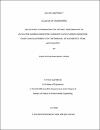Graphene/TiO2 composite electrode: Synthesis and application towards the oxygen reduction reaction
| المؤلف | Al-Kandari, Halema Ali |
| المؤلف | Abdullah, Aboubakr Moustafa |
| المؤلف | Mohamed, Ahmed meslam |
| المؤلف | Al-Kandari, Shikah Ali |
| تاريخ الإتاحة | 2025-07-21T04:19:02Z |
| تاريخ النشر | 2014 |
| اسم المنشور | ECS Transactions |
| المصدر | Scopus |
| المعرّف | http://dx.doi.org/10.1149/06139.0013ecst |
| الرقم المعياري الدولي للكتاب | 1938-6737 |
| الملخص | A graphene oxide (GO) was prepared from a commercial graphite nano-crystals using Hummers’ method. Later, GO powder was reduced either by placing it under a H2 gas flow in a controlled gas reactor at 450 oC or using a hydrazine hydrate solution (HH) in a 1000-Watt microwave oven. X-ray photoelectron spectroscopy (XPS) and X-ray diffraction patterns (XRD) confirmed that both of the oxidation and reduction processes of graphite and GO powders, respectively, were incomplete. Also, the surface area of the H2 gas - reduced GO powder was found to be higher than the case where HH was used to reduce the same powder. Fourier transform infrared spectroscopy (FT-IR) and XPS have revealed that GO surface consists mainly of hydroxyl, epoxy, carbonyl and carboxylic groups. The electrocatalytic properties of (i) glassy carbon (GC), (ii) commercial TiO2 (P25-TiO2/GC), (iii) TiO2-supported GO (GO/TiO2/GC), (iv) TiO2 – supported HH – reduced GO (HHRGO/TiO2/GC) and (v) TiO2 – supported H2 gas – reduced GO (H2RGO/TiO2/GC) electrodes towards the oxygen reduction reaction (ORR) in acidic solution in presence and absence of UV radiation were examined. The results have shown that the H2RGO/TiO2/GC electrode has the best electrocatalytic activity in terms of current at a certain potential but glassy carbon electrode (GC) was found to be the best in terms of the onset potential of the ORR. |
| اللغة | en |
| الناشر | Electrochemical Society Inc. |
| الموضوع | Graphene oxide synthesis Reduction methods of graphene oxide Electrocatalytic oxygen reduction reaction TiO2-supported graphene electrodes Surface characterization of graphene oxide |
| النوع | Conference |
| الصفحات | 13-26 |
| رقم العدد | 39 |
| رقم المجلد | 61 |
الملفات في هذه التسجيلة
هذه التسجيلة تظهر في المجموعات التالية
-
الأبحاث [1633 items ]



